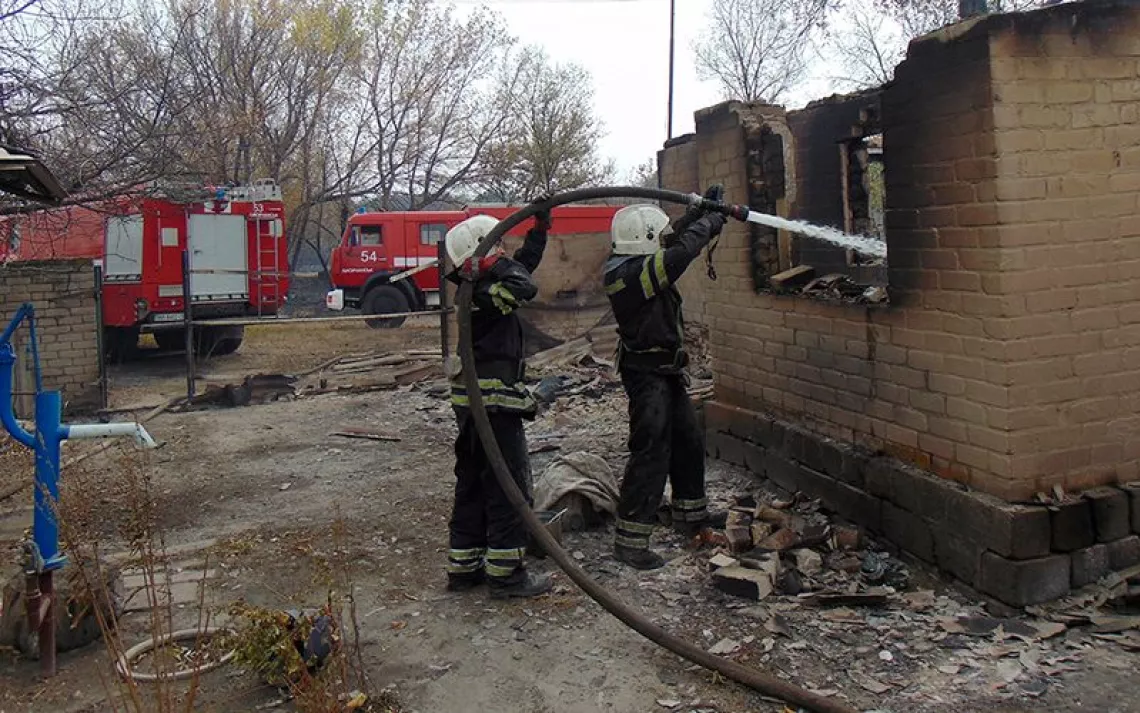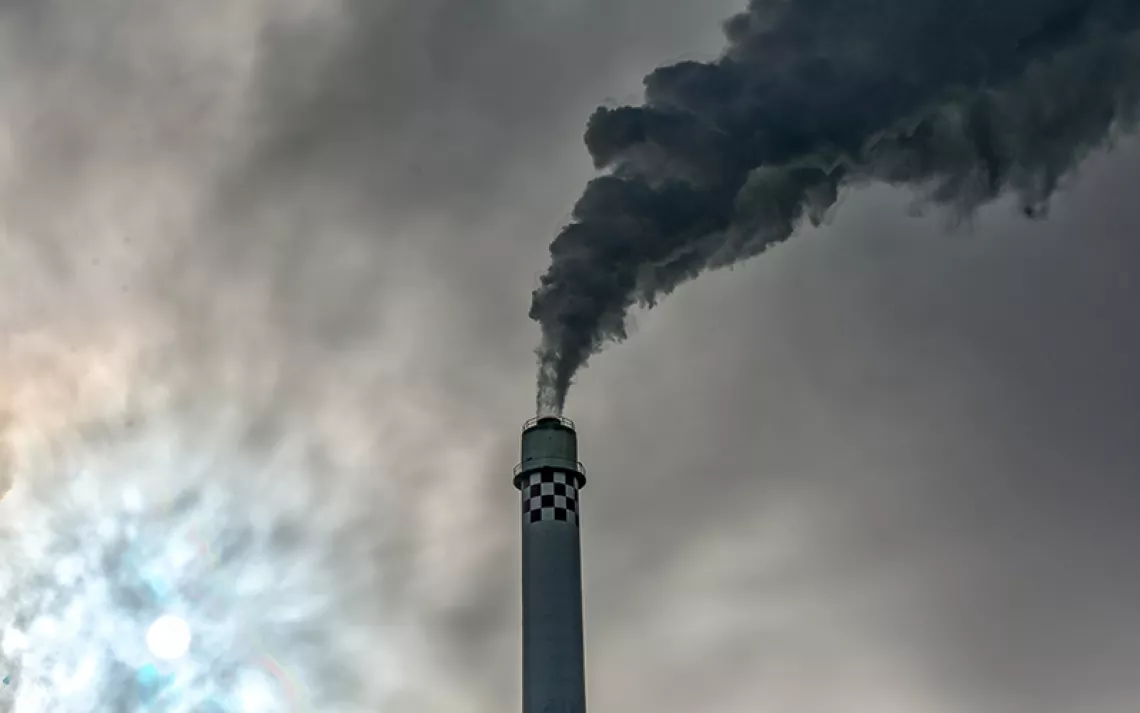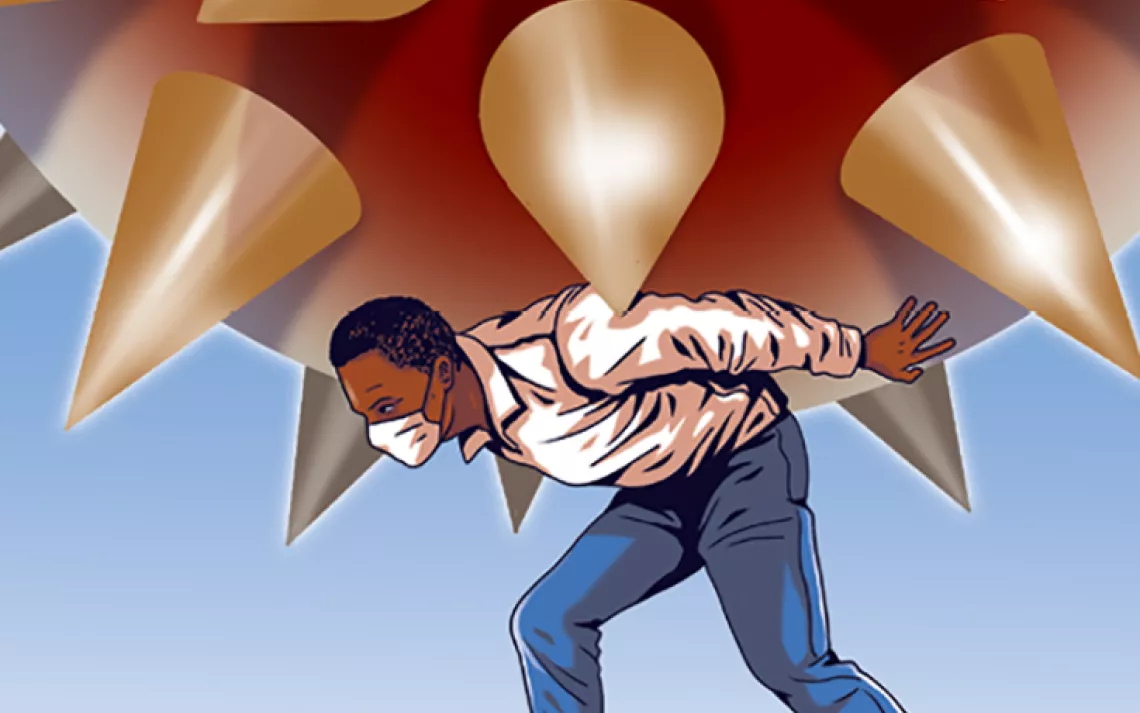Is This Why Detroiters Are Dying From the Coronavirus?
Why did it take a pandemic to turn Detroit’s water back on?

Rabbi Yosef Chesed carries water for distribution at the Brightmoor Connection Food Pantry in Detroit, March 23, 2020. | Photo by AP Photo/Paul Sancya
<>Maureen Taylor first learned about the existence of COVID-19 in January, scrolling through the BBC website. A few weeks later, a contact at the United Auto Workers told her that Ford’s factories in China were shut down because of the virus. “So Ford knew,” said Taylor. “Ford knew in February.”
Then news reports about COVID-19 began appearing on local television. Avoid gathering in groups, the newscasters said. Stay isolated, and don’t go into work if you are feeling ill. Above all, wash your hands.
Taylor couldn’t believe what she was seeing. As chair of the Michigan Welfare Rights Organization (MWRO), an anti-poverty group with roots in the civil rights movement and the Poor People’s Campaign, and a founding member of the People’s Water Board, Taylor knew far too much about who in Michigan was actually able to follow this advice.
“It was enraging,” said Taylor, “to hear these voices on TV telling people to wash and wash and wash and wash your hands, when you know that people don’t have any water.”
In 2019, the Detroit Water and Sewerage Department (DWSD) cut service to 23,473 homes whose occupants had fallen behind on their bills—a 44 percent increase over the year before. In January of 2020, an investigative report by Bridge Magazine found that 9,500 of those homes were still without water (DWSD disputed this, saying that according to their own internal documents, the number was about half that). Even after water was shut off, DWSD charged each household $27 a month for being connected to the city sewer system.
These shutoffs had been a problem for a long time. MWRO routinely helps members negotiate with utility companies that are trying to saddle them with suspiciously high bills or high reconnection fees. But almost 20 years ago, organizers with the group began to hear rumors that senior citizens in the area were living without running water but were too embarrassed to admit it.
The rumors were true, and as the cost of water rose, they only became more so. Detroiters pay some of the highest water rates in the Great Lakes region—an average of $96 per month. Thirty-six percent of city residents live on incomes that are below the federal poverty line ($12,490 for a single person, $25,750 for a family of four). Perversely, low-income households often get larger bills, because they are more likely to live in buildings with faulty pipes.
DWSD struggles with almost every aspect of being a utility. City residents deal with leaky pipes, sinkholes, and flooded basements. DWSD doesn’t exactly have it easy—the utility is delivering water through an antiquated system that was built out for a city that is now at a third of its former population. But DWSD does not make it easy for anyone else either. Unexpected bills for thousands of dollars are not uncommon. (“Don't plead hardship; it doesn't work,” reads one guide to contesting a DWSD water bill.)
In 2005, the People’s Water Board worked with a utilities expert and developed an income-based water payment plan for the city of Detroit. Various programs existed to help low-income Detroiters with water bills, but they required tenacity to navigate, often ran out of funding, and demanded a strict timeline for bill payment that was difficult for people with unreliable incomes to meet. To the board, a real solution to the growing water problem was not an occasional grant or payment plan or act of generosity to help Detroiters pay bills that were out of their reach. The solution was to bring the bills into alignment with what income residents did have.
The plan was approved by the city council but never funded through the city budget. The board kept trying. In 2014, when the DWSD shut off water to a record 33,000 homes, Taylor gave a reporter from NBC such a dressing down on live television—for saying that some Detroiters were getting their water shut off because they “would rather spend money on cable”—that she became, briefly, internet famous.
To the People’s Water Board, depriving people of water is every kind of disaster: a human rights disaster (the UN considers access to clean water and sanitation to be an essential human right); an economic disaster (it’s hard to find and hold onto a job when you can’t take a shower or wash your clothes); a mental health disaster (children living in a house without water could be taken away by Child Protective Services and put into foster care); a moral disaster (Detroit pastor and former city council member Jo Ann Watson called the DWSD shutoffs “a disgrace before God;” and an epidemiological disaster (it’s not just COVID-19—the spread of just about every communicable disease, from Hepatitis A to norovirus to staph, can be mitigated by washing your hands.)
To DWSD, depriving some people of water is necessary, in order to keep people paying their bills. After 2014’s record number of shutoffs made the national news, Detroit’s mayor declared a moratorium on new shutoffs—but only temporarily. A court case over whether the shutoffs could be extended further revealed why: DWSD's deputy director, Darryl Latimer, testified that during the shutoffs, the utility had brought in "record-breaking" revenues—as much as $1 million a month. People would make almost any financial sacrifice to keep the water running—a 2018 survey of low-income residents in Detroit and its surrounding suburbs found that, on average, they were spending 10 percent of their income to keep the water on. And 84 percent of them reported going without food, school supplies, car repairs, or medical and dental care in order to keep paying their water and sewer bill.
In May 2019, Lori Lightfoot, the mayor of Chicago declared a moratorium on water shutoffs, calling them “a heartless act.” In July, inspired by her act, the ACLU of Michigan and a coalition of other groups petitioned the Detroit Department of Health and Human Services to do the same, on the grounds that widespread shutoffs in the Brightmoor neighborhood were leaving water stagnating in certain parts of the system, which increased the risk of encountering dangerous bacteria to anyone in the area.
The shutoffs were also, the ACLU continued, affecting the health of Brightmoor residents. People were becoming ill from drinking rainwater, and there was a local outbreak of urinary tract infections and skin rashes. “While some might discount the seriousness of the health conditions described above,” read the letter, “what makes the reported illness stand out is that they are all preventable. Because of the lack of access to running water, these illnesses occur easily.”
In September, DHHS declined the request. “Imminent danger,” wrote its director, Mark P. Fancher, “as defined by MCL 333.2251(5)(b) means “a condition or practice that could reasonably be expected to cause disease, death, or serious harm.” So the ACLU of Michigan submitted it again, this time to Gretchen Whitmer, the governor of Michigan. On February 26, Whitmer’s attorney turned the request down with the same response that DHHS had given.
Two days later, Whitmer activated Michigan’s Emergency Operations Center to coordinate with state, local, and federal agencies to help prevent the spread of the novel coronavirus. “Michiganders can be assured that we are taking this seriously and we will continue to make preparations to limit the spread and impact of COVID-19,” said Dr. Joneigh Khaldun, chief deputy for health for the Michigan Department of Health and Human Services, in a press release. “Everyone can do basic things like washing hands frequently.”
On March 9, Detroit’s mayor, Mike Duggan, and Governor Whitmer took an unprecedented step and announced that DWSD would start turning the water back on for any household that could pay $25 a month—and that the state would cover the first month for free. A day later, Michigan officially reported its first confirmed cases of COVID-19—both in the metro Detroit area. The virus had likely been in the area for weeks, being mistaken for the common cold or pneumonia. “What a hot mess,” said Taylor, about the sudden, too-late reversal. “Nobody could hear the voices of the people without water. But this little bitty microbe that you can’t even see, people heard the voice of the virus.”
The day of the announcement, the DWSD got 1,900 calls to restore service—so many that it crashed its phone system. The utility’s estimate of how many houses in Detroit needed water turned back on were much lower than the 9,500 the Bridge had reported: only 2,800. (MWRO submitted a FOIA request for the addresses of the homes that they shut off, but DWSD refused, saying it was a privacy violation). DWSD said that, out of the first 1,900 calls, 500 were being processed. “I remembered what the governor said,” said Taylor. “She did not say 'processed.' She said 'restored.'”
By March 18, water had only been restored to 290 homes. A week later, Gary Brown, DWSD’s director, told Detroit’s city council that the number of restorations had risen to 700, but admitted he didn’t actually know how many homes were still without water.
Meanwhile, the People’s Water Board was working to provide water to those in need, like it had always done. Now, in the face of a pandemic, things had gotten exponentially more complicated. For years, the organizers had accepted and distributed donations of bottled water from three locations in Detroit, but with COVID-19 on the loose, these were now looking like potential infection hubs.
The board switched to delivery—but frequently there was nothing to deliver, because a rash of panic buying cleared grocery store shelves of bottled water across the county. Everyone had to scrounge for protective gear. “I’ve got 10 pairs of gloves,” said Taylor. “I’m always washing them and hanging them out to dry. I can’t get sick. I’ve got too much work to do.”
A staffer at MWRO developed COVID-19 symptoms and was hospitalized. Nicole Hill, another staffer at MWRO, had been helping her prepare a water delivery a few days before. Both of them were wearing masks and gloves, but, said Hill, it’s not easy to pass a case of water to someone while staying six feet away. Hill put herself into quarantine, separating herself from everyone, including her two teenage children. She kept coughing and hoped it was just her asthma. In other cities, reduced traffic due to shelter-in-place orders had improved the air quality, but in Detroit—home to the state’s only oil refinery—that did not seem to be the case. A few days later, her coworker was released from the hospital, but not in a way that Hill found especially reassuring. “They sent her home with oxygen because they literally needed the bed.”
On March 28, Governor Whitmer ordered every utility in Michigan to turn back on the water for anyone who had been disconnected for nonpayment. Taylor was delighted—she’d always insisted that Detroit was just a symptom of a national unwillingness to acknowledge how much the deck was stacked against the poor, no matter what city they happened to live in. “The story is also that this is Detroit. That people are corrupt and hiding their money in the attic. Or that we are too stupid to pay our bills. Now it’s, 'We have to do something for those ignorant people in Detroit.' But anyone living without water deserves to have it turned back on. Everywhere.”
Hill worries about what might come next. The governor hasn’t responded to the board’s other public health requests, like setting up water stations with cleaning supplies across the city. “The governor’s declaration of emergency was a good step,” said Hill, “but it was just that, a step. We still need some kind of enforcement to make sure that the water is actually being turned back on. If you are going to have oversight, you need people in the city. You don’t know this city. You’re in Lansing.”
Hill also worries that even in households where the water is restored, residents could get sick from the bacteria that built in the system if they don’t flush out their pipes properly. “In some households, the water has been off for close to five years,” she said, pausing to cough. “They leave them with instructions for flushing out the pipes, but they may not know how to do it. If the water gets turned back on without flushing out the pipes properly, we risk Hep A. Legionnaires, lead, typhoid, cholera. These people are going to be so excited they are having water, they are not going to realize what’s been sitting in the pipes.”
And those water restorations will only last as long as the governor considers COVID-19 to be at pandemic levels. “Residents were told the first 30 days that the state pays the cost,” said Hill, about an announcement she saw about the water restorations. “After that, it’s $25/month. But down at the bottom, like a contract should be if you want to get over on people, it says, “Only until the end of the COVID epidemic.'”
By April 23, nearly 3,000 people in Michigan were dead because of COVID-19. Among them were Marlowe Stoudamire, director of the Detroit Historical Museum's award-winning history of the 1967 uprising; Laneeka Barksdale, a Lyft driver and star of the local ballroom dancing scene; Divina Accad, a nurse at the Detroit VA Medical Center; Jason Hargrove, a city bus driver who kept working through the pandemic because he considered himself to be a first responder; legendary house-music D.J. and producer Mike Huckaby; and Skylar Herbert, the five-year-old daughter of a Detroit firefighter and a policeman. Over a quarter of Michigan’s COVID-19 victims lived in Detroit, even though the city is home to only 6.7 percent of the state’s population.
“How many people?” asked Taylor. “Our bus drivers, our hospital workers, our policemen. How many people ended up getting this virus because they came into contact with someone who couldn’t wash their hands?”
 The Magazine of The Sierra Club
The Magazine of The Sierra Club



